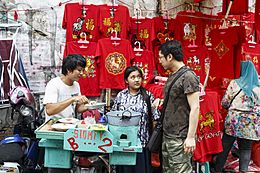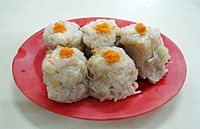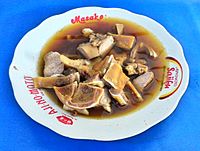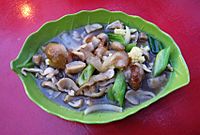Chinese Indonesian cuisine facts for kids

Chinese Indonesian cuisine is a special mix of Chinese food and local Indonesian cuisine. Many Chinese Indonesians are descendants of people from China who spoke Hokkien and Hakka languages. They brought their amazing cooking traditions with them. Over time, they added Indonesian ingredients like kecap manis (sweet soy sauce), palm sugar, peanut sauce, chili, santan (coconut milk), and local spices. This created a unique blend of flavors! Some of these dishes are also similar to Nonya cuisine found in Malaysia and Singapore.
Contents
Chinese Food in Indonesia
You can see Chinese influences everywhere in Indonesian cuisine. Many favorite Chinese foods have become super popular in Indonesia. Some of these include bakmi, mie ayam, pangsit, bakso, lumpia, kwetiau goreng, and mie goreng.
Many Indonesian food words come from Chinese languages like Hokkien, Hakka, and Cantonese. For example, words starting with bak (meaning 'meat' in Chinese) show that meat is in the dish, like bakpau (a meat bun). Words ending with cai (meaning 'vegetables') mean vegetables are involved, like cap cai (mixed vegetables). Also, mi or mie (meaning 'noodle') is used for noodle dishes like mie goreng (fried noodle).
These Chinese words are now a big part of the Indonesian language. Many Indonesians don't even realize these words came from Chinese! Famous Indonesian dishes like nasi goreng, mie goreng, bihun, kwetiau, lumpia, and bakpia all have Chinese roots. These foods are eaten daily by many people in Indonesia.
Chinese food is especially popular in cities with large Chinese communities, like Jakarta, Semarang, Surabaya, and Medan. Because of this, many noodle and tofu recipes were created in these cities. Even native Jakartans (called Betawi people) enjoy Chinese Indonesian dishes like asinan and rujak juhi. People in Java also love Chinese-influenced foods like mie goreng, lumpia, and bakso.
Chinese families often enjoy eating out together. This is why many Chinatowns in Indonesian cities are famous for their amazing food. You can find all sorts of places, from small street carts to fancy restaurants. Places like Glodok in Jakarta and Kesawan in Medan are full of delicious food spots.
How Chinese Food Changed in Indonesia
Chinese Indonesian cuisine changes depending on where you are in Indonesia. For example, in different parts of Java, the food is adjusted to local tastes. In Central Java, food is often sweeter. In West Java, it's saltier. In East Java, it's more savory and often uses petis (shrimp paste). In Medan and Pontianak, you might find food that tastes more like traditional Chinese dishes.
Chinese cuisine in Indonesia has also become spicier, using local ingredients. It's common to add sambal (chili sauce), acar (pickles), and crispy fried shallots (bawang goreng) to dishes.
Chinese food has influenced Indonesian food, but Indonesian food has also influenced Chinese Indonesian food! For example, Lontong cap go meh is a Chinese Indonesian dish that mixes traditional Indonesian foods. It shows how Chinese immigrants blended with the local communities.
Since Indonesia is a country with many Muslim people, some Chinese dishes have been changed to be halal (allowed in Islam). This means replacing pork with chicken or beef, and using palm oil or chicken fat instead of lard. However, in Chinatowns where there are many Chinese and non-Muslim people, you can still find restaurants that serve pork dishes like babi kecap (pork belly in soy sauce) and sate babi (pork satay).
There are different kinds of Chinese food you can find in Indonesia:
- Traditional Chinese dishes, like those from Teochew, Hokkien, and Hakka areas.
- Chinese-Indonesian food that has borrowed recipes from local Indonesian, Dutch, and other European cuisines.
- Chinese dishes that have been changed to fit local tastes, like using chicken or beef instead of pork to make them halal.
- Newer Chinese food styles brought by chefs from China, Hong Kong, or Taiwan.
List of Chinese Indonesian Food
Often, Chinese Indonesian food names come from their original Chinese Hokkien names, like bakmi or lumpia. But sometimes, the names are translated into Indonesian, describing what's in the dish or how it's made, like babi kecap or nasi tim.
Main Dishes
- Asinan: Preserved vegetables in a thin peanut sauce, served with krupuk mie.
- Ayam kluyuk or koloke: Chicken in sweet and sour sauce.
- Babi hong: Pork belly cooked in many Chinese sauces and spices.
- Babi kecap: Pork belly in sweet soy sauce and spices.
- Bakcang or bacang: Glutinous rice filled with meat (often pork) and wrapped in a bamboo leaf.
- Bak kut teh: Pork rib soup made with herbs and spices.
- Bakkwa: Dried meat, like jerky.
- Bakmi: Noodles adapted to different styles and regions. Each city has its own noodle recipe!
- Bakpau: Steamed bun, filled with chicken, meat (often pork), or sweet mung beans.
- Bakso: Beef or chicken meatballs, usually served in a broth.
- Bakso ikan: Meatballs made from fish, served in broth.
- Bakwan: Fried dish with vegetables, batter, and sometimes beef.
- Banmian: Handmade flat noodles in a soup.
- Bihun goreng: Fried thin rice noodles with spices and chili, often darkened with sweet soy sauce.
- Bubur ayam: A chicken congee (rice porridge).
- Cakwe: Chinese fried bread, served with a sweet, sour, and spicy dipping sauce.
- Cap cai: Mixed vegetables, usually stir-fried with chicken.
- Char kway teow: Stir-fried rice noodles with bean sprouts, prawns, eggs, and Chinese sausages. Similar to kwetiau goreng.
- Cha sio: Barbecued pork, often served with rice.
- Fu yung hai or pu yung hai: An omelet filled with vegetables and meat (like crab or shrimp), served in sweet and sour sauce.
- Haisom cah: Stir-fried sea cucumber with garlic, mushrooms, and sauces.
- I fu mie: Dried noodles in a thick sauce with meat or seafood.
- Kakap asam manis: Red snapper in sweet and sour sauce.
- Kepiting saus tiram: Crab in oyster sauce.
- Kwetiau ayam: Boiled flat noodles with diced chicken.
- Kwetiau goreng: Fried flat noodles, similar to char kuay teow.
- Kwetiau siram sapi: Flat noodles with beef in a thick gravy.
- Laksa: Spicy noodle soup, popular in Indonesia, Malaysia, and Singapore.
- Lumpia: A fresh spring roll.
- Lontong cap go meh: Rice cakes in rich coconut milk with chicken, liver, and vegetables. Served during the Chinese New Year festival, Cap Go Meh.
- Locupan: Short, "rat's tail-like" noodles.
- Mie ayam: Chicken noodles, topped with diced chicken and usually served with chicken broth.
- Mie campur or bakmie campur: Noodles topped with different Chinese barbecued meats like Char Siew and crispy roast pork.
- Mie goreng: Fried noodles with spices and chili, often darkened with sweet soy sauce.
- Mie hokkien: Stir-fried or soupy noodle dish with egg and rice noodles.
- Lomie: Thick yellow noodles in a gravy made from eggs, starch, and pork stock.
- Mie pangsit: Thin egg noodles with wonton dumplings.
- Mie tarik: "Pulled noodles," also known as la mien.
- Mie yamin or Yamien: Chicken noodles in sweet soy sauce, sweeter than mie ayam.
- Mun tahu: Silken tofu with shrimp and minced chicken in a thick white sauce.
- Nasi ayam or Nasi Hainan: Poached chicken and seasoned rice, served with chili sauce.
- Nasi bebek: Rice dish with braised or roasted duck.
- Nasi campur (Chinese Indonesian version): Rice with different Chinese barbecued meats, like Char Siew and pork satay.
- Nasi goreng: Fried rice with spices and chili, often with kecap manis.
- Nasi tim: Steamed chicken rice served with chicken broth.
- Ngo hiang or lor bak: Minced meat roll (pork, chicken, fish, or prawn) seasoned with five-spice powder.
- Otak-otak: Steamed and grilled fish cake in a banana leaf package, served with spicy peanut sauce.
- Pangsit: Wontons filled with vegetables, chicken, or shrimp.
- Pangsit goreng: Fried wontons.
- Pangsit kuah: Wontons in a broth or gravy.
- Pek Cam Kee’’’: Marinated steamed white chicken.
- Pempek: A savory fishcake from Palembang, made of fish and tapioca, served with spicy vinegar and palm sugar sauce.
- Popiah: A large, fresh, unfried spring roll, similar to lumpia.
- Rujak juhi: Preserved vegetables in peanut sauce with yellow noodles and salted cuttlefish.
- Rujak Shanghai: Preserved seafood and jellyfish with vegetables and sweet and sour sauce.
- Sate babi: Pork satay, found in Chinatowns and popular in Bali.
- Sapo tahu: Tofu cooked in a clay pot to keep it warm, often with vegetables, chicken, or seafood.
- Sekba: A traditional Chinese soup with pork offals (like intestine, liver, heart) and salted vegetables in a spiced broth.
- Siomay: Steamed ground fish dumplings, similar to Chinese dim sum, but usually served with spicy peanut sauce in Indonesia.
- Soto: A traditional Indonesian soup with broth, meat, and vegetables.
- Soto mi: A spicy noodle soup.
- Sup hisit: Shark fin soup.
- Sup sarang burung: Edible bird's nest soup.
- Swikee: A dish made from frog legs.
- Tahu: Fermented soy food, also known as 'bean curd'.
- Tahu Bandung or tahu yun yi: Firm but soft tofu with a yellow skin from Bandung.
- Tahu goreng: Fried tofu with peanut sauce or sweet soy sauce and chili.
- Tahu tauco: Tofu in tauco (fermented soybean) sauce.
- Tauge ayam: Bean sprouts and chicken with soya sauce.
- Tauge tahu: Stir-fried bean sprouts and tofu.
- Telur asin: Salted duck egg.
- Telur dadar tiram: Omelet filled with small oysters.
- Telur pitan: Black-colored preserved duck egg.
- Telur teh: Tea egg.
- Telur tim: Steamed egg.
- Terang bulan/Martabak manis: A sweet pancake with fillings like crushed peanuts, sugar, chocolate, and cheese.
- Tim daging: Steamed minced meat (often pork) and eggs.
- Yong tau fu: Tofu filled with ground meat or fish paste.
- Yusheng or yee sang: Fresh fish salad with sliced vegetables, usually served during Chinese New Year.
Desserts and Sweets
- Bakpia: Sweet mung bean-filled pastry from Fujian. Famous in Yogyakarta as bakpia Pathok.
- Cincau: Grass jelly drink served with shaved ice, coconut milk, and sugar.
- Kembang tahu: Soft tofu pudding in sweet ginger and sugar syrup.
- Kuaci: Edible dried and salted watermelon or sunflower seeds.
- Kue bulan or tiong chu pia: The local name for Chinese mooncake.
- Kue keranjang or dodol cina: The local name for nian gao, a sweet glutinous rice cake.
- Kue ku: Chinese cake made of sticky rice flour with a sweet filling, similar to "Ang ku kueh" (Red Tortoise Cake).
- Kue moci: Glutinous rice filled with peanut paste and covered with sesame seeds.
- Nopia: Palm sugar-filled pastry, smaller than bak pia.
- Onde-onde: A fried glutinous rice ball filled with peanut paste and covered with sesame seeds.
- Ronde: Sweet dumplings made from glutinous rice flour, filled with peanut paste, floating in hot ginger and lemongrass tea.
- Sekoteng: A hot ginger-based drink with peanuts, diced bread, and tapioca pearls.



















